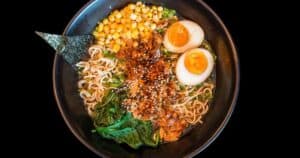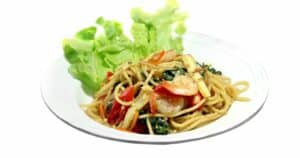Koreans definitely love their ramen noodles! But do they really eat them every single day? This iconic dish holds a special place in Korean food culture. With its convenience, affordability, and delicious flavors, it’s no wonder ramen is so popular.
The answer is – some Koreans may eat ramen daily, but not all. Students and young adults are more likely to eat it frequently as an inexpensive meal. One study found 57.6% of Korean adults ate ramen weekly. But only 5.8% ate it daily.
While ramen offers a quick fix, too much can impact health. This article will explore the story behind Korea’s ramen craze. We’ll look at the health effects of excessive ramen, plus tips for enjoying it in moderation. Get ready to slurp up some ramen knowledge!
Do Koreans Really Eat Ramen Every Day?
So do Koreans actually eat ramen daily? The short answer is – sometimes! Here are some key facts:
- For many Koreans, ramen consumption is occasional, not daily. It’s often viewed as more of a snack or quick meal.
- However, some Koreans, especially students and young adults, may eat ramen daily as it’s affordable and convenient.
- One study found 57.6% of Korean adults ate ramen once a week or more. But only 5.8% consumed it every day.
- Ramen consumption does seem high. Korea is the second largest instant noodle market globally after China.
- But traditional Korean meals with rice, veggies and soups are still important in the culture.
A Brief History of Ramen in Korea
Ramen originated in Japan, but Koreans have made it their own. Here’s a quick look at how ramen became so popular in Korea:
- 1963 – Instant ramen was created in Korea as an affordable meal option after the Korean war. It was inspired by Japanese instant noodles.
- Korean ramen used local flavors like kimchi to create a unique style.
- Convenience and budget friendly prices made ramen spread quickly.
- Today ramen is available everywhere – homes, convenience stores, restaurants.
- With so many flavors and options, ramen has become a cultural staple.
Why Koreans Love Ramen So Much
There are a few key reasons why ramen is so popular in Korea:
- Convenience – Ramen cooks up fast, making it perfect for busy lifestyles.
- Affordability – Ramen is cheap, especially for students and young adults. A meal can cost just a dollar or two.
- Comfort food – Warm, tasty ramen is soothing and nostalgic.
- Variety – Koreans enjoy the many flavors of ramen – spicy kimchi, seafood, cheese ramen and more.
- Customizable – Toppings like eggs, vegetables and meat can be added.
- Social experience – Eating ramen with friends or family is a bonding experience.
The Convenience Factor: Why Koreans Prefer Quick Meals
Koreans strongly prefer quick, easy meals due to their busy lifestyles and limited time to prepare food. With fast food readily available and tasty, it’s no wonder why Korean adolescents also enjoy fast food. But remember traditional Korean meals, served with rice, broth dishes, kimchi, and various side dishes.
Despite emphasizing side dishes, Koreans have a relatively low obesity rate due to consuming different kinds of vegetables and foods.
Now let’s dive a little deeper into a convenience in Korean cuisine.
- One of the most convenient and popular Korean dishes is bibimbap, which consists of rice, meat, assorted vegetables, and a fried egg. These ingredients can be easily prepared in advance and assembled quickly for a tasty and filling meal. It’s no surprise that bibimbap is a staple meal for Koreans on the go!
- Convenience stores in Korea offer a wide variety of quick and easy meal options such as triangular kimbap, tteokbokki, fried chicken, and instant ramen. With these options available 24/7, Koreans can satisfy their hunger cravings at any time of the day. Convenience stores have become such an integral part of Korean culture that they even have their name, “CVS,” Some chains even offer seating areas for customers to eat inside.
- While quick meals are a popular choice in Korea, many still prioritize health over convenience. One trend that has emerged in recent years is the rise of “well-being” restaurants and cafes that offer healthy and nutritious options. These restaurants often use organic and locally sourced ingredients to create delicious and healthy dishes. Additionally, meal delivery services have become increasingly popular, allowing busy Koreans to order healthy meals delivered to their doorstep.
The Affordable Price Tag: A Key Reason for Ramen’s Popularity
Ramen’s popularity in Korea can be attributed to its affordable price tag. This comfort food is convenient and readily available in Korean grocery stores. Plus, it’s easy to cook, making it a popular option for busy people or on a tight budget. Ramen has become a cultural staple in Korea, with various varieties and flavors.
Ramen’s affordability has made it a go-to meal in Korea for students and young adults. It’s a quick, easy, and budget-friendly meal that can be enjoyed anytime, anywhere. For many people, ramen has become a part of their daily routine. It’s common for some Koreans to eat ramen daily, either as a meal or a snack.
One of the reasons why ramen is so cheap in Korea is because of the high demand for it. Korean manufacturers produce large quantities of ramen noodles daily to keep up with the order. This large-scale production makes it possible to sell ramen at a lower price point than other types of food.
While some may argue that the price tag is the only reason for ramen’s popularity in Korea, the truth is that it’s also a delicious and satisfying meal.
Ramen comes in many different flavors, from mild to spicy, and is often customizable with toppings like eggs, seaweed, and vegetables.
The Various Flavors and Versatility of Ramen
Ramen is a go-to meal for many Koreans due to its convenience, affordability, and delicious taste. With so many different variations and flavors, Koreans can never get tired of enjoying this staple dish.
Let’s dive deeper into the different flavors and variations of ramen:
- Beef-based broth: This type of ramen is rich and savory, perfect for meat lovers. The broth is made with beef bones, vegetables, and spices, giving it a deep, hearty flavor.
- Chicken-based broth: If you prefer a lighter broth, chicken-based ramen is for you. It has a mild yet flavorful taste and is perfect for those seeking a healthier option.
- Seafood: Seafood ramen is an excellent choice for seafood lovers. It is made with various seafood, such as shrimp, fish, squid, and clams, giving it a fresh, oceanic taste.
- Kimchi flavor: Kimchi ramen is a must-try for those who love spicy food. It is made with kimchi, a traditional Korean side dish made of fermented vegetables, and has a spicy, tangy taste.
- Ham flavor: Ham ramen is a famous instant noodle in Korea. It has a smoky flavor and is perfect for a quick, easy meal.
Korean ramyeon also offers various flavors, such as spicy curry ramyeon, black bean sauce ramyeon, and cheese ramyeon. In addition to the tastes, ramen can be enjoyed with multiple toppings such as sliced pork belly, soft-boiled eggs, scallions, and mushrooms.
The versatility of ramen makes it a perfect dish for any occasion. It can be enjoyed as a quick snack, a lunchtime meal, or even a late-night craving. And with the various flavors and toppings, the possibilities are endless.
The Role of Ramen in Korean Culture
Ramen has become more than just food, it brings emotional and cultural significance. Let’s dive deeper into The Role of Ramen in Korean Culture:
- Ramen is a Comfort Food: With busy lifestyles and stressful work environments, ramen is a go-to comfort food for Koreans. It has a calming effect and brings a sense of familiarity and warmth to one’s day.
- Ramen is an Affordable Meal: Korean college students and young adults tend to live on a tight budget, making ramen an affordable meal that can fill them up. It’s no wonder why ramen is a staple in Korean households.
- Ramen is a Social Experience: Ramen is a meal that brings people together. Koreans often bond over a late-night bowl of ramen with friends, family, or strangers. Many Korean dramas and movies have scenes of characters slurping on a bowl of family-sized ramen with chopsticks, evoking a sense of togetherness and warmth.
Ramen has a special place in modern Korean culture, and its cultural significance will never fade. From its comforting and affordable nature to its ability to bring people together, ramen is more than just a meal. It’s a tradition that continues to bring joy to Koreans every day.
Is Eating Ramen Every Day Bad For You?
Ramens convenience does come with some health concerns if eaten too frequently. Here’s an overview:
Nutrition pros:
- Provides carbohydrates for energy
- Can include protein from eggs, meat or seafood toppings
Nutrition cons:
- High in sodium – one package can have over 50% of daily recommended sodium intake
- High in fat, especially saturated fat
- Low in fiber, vitamins and minerals
- Lacks probiotics and gut-healthy foods like fermented vegetables
Health risks of too much ramen:
- High blood pressure from excess sodium
- Heart disease risk from saturated fat
- Obesity from high calories with little nutrition
- Poor gut health from lack of fiber and probiotics
So while an occasional ramen meal is fine, consuming it too frequently can negatively impact health. Moderation and balance is key.
The Future of Ramen in Korea: Will the Craze Continue?
The craze for ramen in Korea will continue in the future, but with a focus on healthier options. According to research data, the South Korean instant noodles market is expected to grow steadily between 2023 and 2028, which indicates a sustained demand for instant noodles in the country.
Low-carb noodles and vegetarian ramen with plant-based broth are expected to become famous. South Korea is also implementing reduced sodium labeling to promote healthier eating habits.
One factor contributing to ramen’s continued popularity in Korea is its cultural significance. Instant noodles were once considered a poor man’s food, but they have become a symbol of Korean history and cultural identity. This suggests that the demand for ramen is not solely driven by convenience or taste but also by cultural factors that will continue to sustain the industry.
Another factor that will drive the future of ramen in Korea is innovation. Korean food producers are constantly developing new flavors, ingredients, and cooking methods to make ramen more appealing to consumers.
This innovation will likely continue as producers explore new ways to make ramen healthier, more sustainable, and more exciting.
Lastly, instant noodles’ popularity in Korea is partly driven by their convenience and low cost. As busy lifestyles and economic pressures continue to be a reality for many Koreans, the affordability and ease of cooking instant noodles will continue to appeal to a large population segment.
Overall, while the ramen craze in Korea may evolve and change, it is likely to continue, focusing on healthier options, innovation, cultural significance, and convenience.





